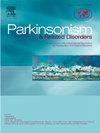关于法国持续输注阿波啡治疗帕金森病和运动波动患者的实际管理德尔菲共识声明。
IF 3.4
3区 医学
Q2 CLINICAL NEUROLOGY
引用次数: 0
摘要
背景:目前对于帕金森病(PwPD)患者开始持续皮下阿波啡输注(CSAI)时如何逐步优化治疗尚无共识指南。目的:为有运动波动的PwPD患者启动CSAI提供实用指南,重点关注阿波啡的目标剂量随时间推移和随后根据患者特点调整口服治疗。方法:一组在治疗晚期帕金森病患者方面具有丰富经验的法国神经科医生根据患者特点采用改进的德尔菲法对CSAI起始进行知识综合。结果:我们根据患者特征确定了5个特征。随着时间的推移,阿波啡的目标剂量和随后口服治疗的调整高度依赖于这些特征。CSAI流速从老年或更敏感患者的最大3mg /h到经历早期波动的年轻患者的6- 10mg /h不等。在大多数情况下,首选的方法是在增加CSAI时同时减少左旋多巴和多巴胺激动剂。为了获得最佳疗效,无论患者的特征如何,左旋多巴当量的总目标剂量(计算为口服剂量和阿波啡剂量的总和)应大于或等于CSAI开始后的起始前剂量。结论:我们根据不同的患者情况,为CSAI开始时调整阿波啡、口服治疗和左旋多巴等效剂量提供了精确的适应症,为患者量身定制。本文章由计算机程序翻译,如有差异,请以英文原文为准。
A delphi consensus statement about French practical management of continuous apomorphine infusion in patients with Parkinson's disease and motor fluctuations
Background
There are currently no consensus guidelines on how to progressively optimize treatment when initiating continuous subcutaneous apomorphine infusion (CSAI) in patients with Parkinson's disease (PwPD).
Aims
To provide practical guidelines on CSAI initiation in PwPD with motor fluctuations, with a focus on the target dose of apomorphine over time and subsequent adjustment of oral treatment according to the patient's characteristics.
Methods
A panel of French neurologists with extensive experience in treating patients with advanced Parkinson's disease used a modified Delphi approach to generate a knowledge synthesis on CSAI initiation according to patient characteristics.
Results
We identified five profiles based on patient characteristics. The target dose of apomorphine over time and the subsequent adjustment of oral therapy were highly dependent on these profiles. The CSAI flow rate varied from a maximum of 3 mg/h for older or more sensitive patients to 6–10 mg/h for younger patients experiencing early fluctuations. In most cases, the preferred approach was to reduce both levodopa and dopamine agonists when increasing CSAI. For optimum efficacy, the total target dose of levodopa equivalent (calculated as the sum of the oral dose and the apomorphine dose) should be greater than or equal to the pre-initiation dose after initiation of CSAI, regardless of patient characteristics.
Conclusion
We provide patient-tailored recommendations with precise indications for the adjustment of apomorphine, oral therapy and levodopa equivalent dose over time during CSAI initiation, based on distinct patient profiles.
求助全文
通过发布文献求助,成功后即可免费获取论文全文。
去求助
来源期刊

Parkinsonism & related disorders
医学-临床神经学
CiteScore
6.20
自引率
4.90%
发文量
292
审稿时长
39 days
期刊介绍:
Parkinsonism & Related Disorders publishes the results of basic and clinical research contributing to the understanding, diagnosis and treatment of all neurodegenerative syndromes in which Parkinsonism, Essential Tremor or related movement disorders may be a feature. Regular features will include: Review Articles, Point of View articles, Full-length Articles, Short Communications, Case Reports and Letter to the Editor.
 求助内容:
求助内容: 应助结果提醒方式:
应助结果提醒方式:


